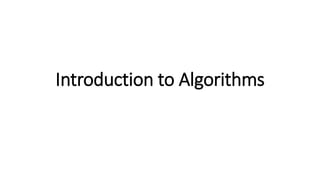Introduction to Algorithms Introduction to Algorithms.pptx
- 2. Introduction to Algorithms Algorithms play a crucial role in computer science, serving as step-by-step procedures or methods for solving specific problems. They are the building blocks that enable computers to perform various tasks efficiently. An algorithm is a finite sequence of well-defined, unambiguous instructions designed to solve a particular problem or perform a specific computation.
- 3. Key Concepts: 1. Algorithm Definition: An algorithm is a set of rules or steps that defines how a particular task is to be performed. It is designed to take inputs, process them, and produce the desired output. 2. Properties of Algorithms: Well-Defined: Every step in the algorithm must be precisely and unambiguously specified. Finiteness: The algorithm must terminate after a finite number of steps. Input: It should accept zero or more inputs. Output: It should produce at least one output. Effectiveness: Each step should be simple enough to be carried out by a human or a computer.
- 4. Key Concepts: 3. Algorithm Analysis: Analyzing the efficiency of algorithms is essential. This involves studying how the algorithm performs in terms of time and space complexity. Time complexity measures the amount of time an algorithm takes to complete based on the input size. Space complexity measures the amount of memory an algorithm uses based on the input size. 4. Algorithm Design Techniques: Divide and Conquer: Break a problem into smaller sub-problems, solve them independently, and then combine the solutions. Greedy Algorithms: Make locally optimal choices at each stage with the hope of finding a global optimum. Dynamic Programming: Solve a problem by breaking it down into overlapping sub- problems and solving each sub-problem only once. Brute Force: Exhaustively try all possible solutions until the correct one is found.
- 5. Key Concepts: 5. Common Algorithms: Sorting algorithms (e.g., Bubble Sort, QuickSort, Merge Sort). Searching algorithms (e.g., Binary Search). Graph algorithms (e.g., Depth-First Search, Dijkstra's algorithm). Dynamic programming algorithms (e.g., Fibonacci sequence). 6. Notation: Big-O notation is commonly used to describe the upper bound on the growth rate of an algorithm's time or space complexity. 7. Applications: Algorithms are used in various fields such as data processing, artificial intelligence, cryptography, optimization problems, and more.





